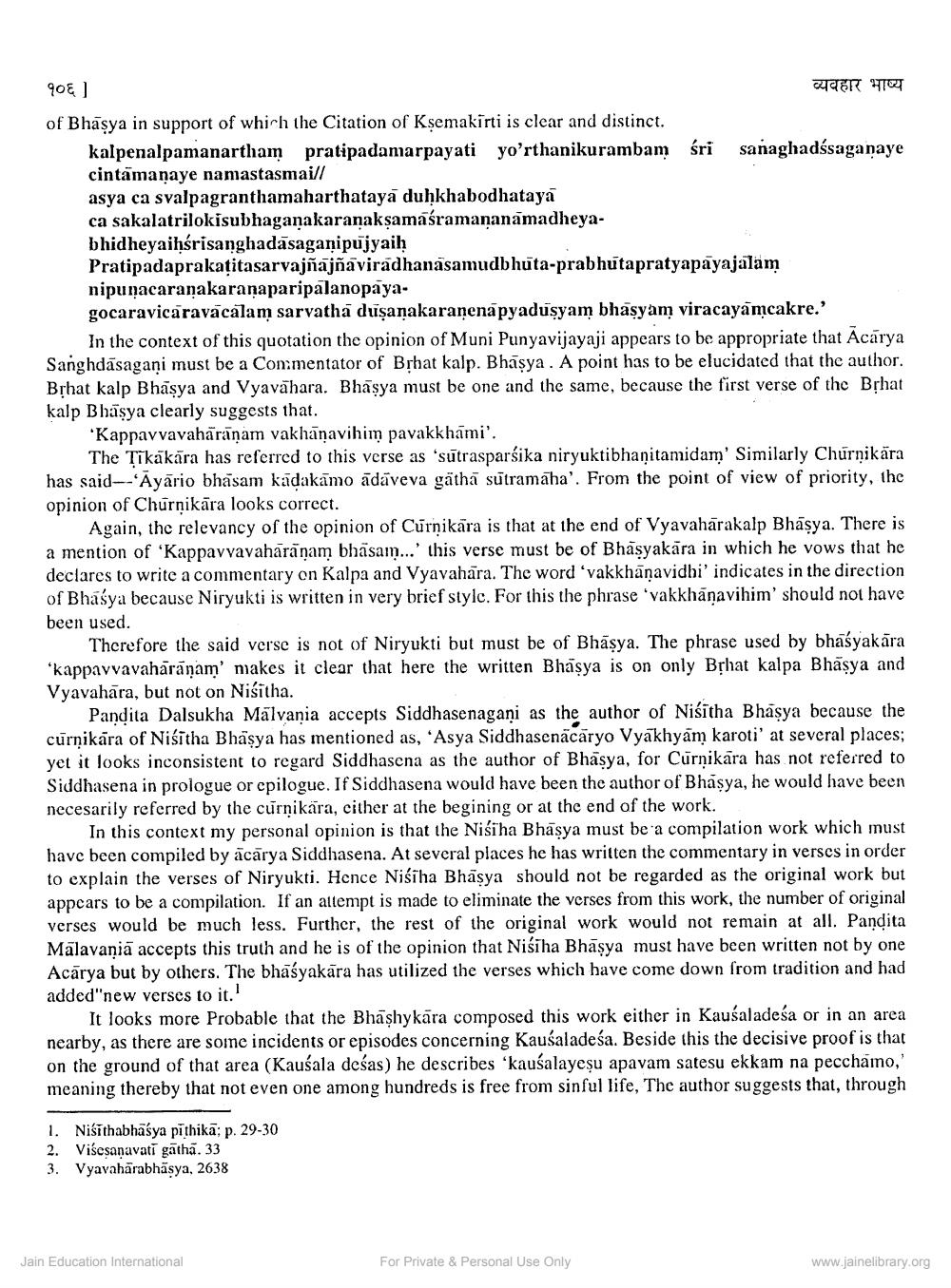________________
90€ ]
व्यवहार भाष्य
of Bhasya in support of whirh the Citation of Ksemakirti is clear and distinct.
kalpenalpamanartham pratipadamarpayati yo'rthanikurambam śri sanaghadssaganaye cintamanaye namastasmai// asya ca svalpagranthamaharthataya duhkhabodhataya ca sakalatrilokisubhaganakaranakşamaśramananāmadheyabhidheyaihsrisanghadāsaganipujyaih Pratipadaprakațitasarvajñajñaviradhanasamudbhuta-prabhutapratyapayajalam nipunacaranakaranaparipalanopayagocaravica ravācalam sarvatha dușanakaranenapyadusyam bhasyam viracayāmcakre.'
In the context of this quotation the opinion of Muni Punyavijayaji appears to be appropriate that Acarya Sanghdāsagani must be a Commentator of Brhat kalp. Bhasya. A point has to be elucidated that the author. Bịhat kalp Bhasya and Vyavahara. Bhasya must be one and the same, because the first verse of the Brhat kalp Bhasya clearly suggests that.
Kappavvavahārāņam vakhānavihim pavakkhāmi'.
The Tīkākāra has referred to this verse as 'sūtrasparsika niryuktibhanitamidam' Similarly Chūrnikära has said--Ayario bhasam kadakamo ādaveva gathā sutramaha'. From the point of view of priority, the opinion of Churnikāra looks correct.
Again, the relevancy of the opinion of Cūrnikāra is that at the end of Vyavahārakalp Bhāsya. There is a mention of 'Kappavvavahārānam bhāsam...' this verse must be of Bhasyakāra in which he vows that he declares to write a commentary on Kalpa and Vyavahāra. The word 'vakkhānavidhi' indicates in the direction of Bhasya because Niryukti is written in very brief stylc. For this the phrase 'vakkhānavihim' should not have been used.
Therefore the said verse is not of Niryukti but must be of Bhāşya. The phrase used by bhaśyakāra *kappavvavaharanam' makes it clear that here the written Bhasya is on only Brhat kalpa Bhasya and Vyavahāra, but not on Niśitha.
Pandita Dalsukha Malvania accepts Siddhasenagani as the author of Niśītha Bhasya because the curņikāra of Niśitha Bhasya has mentioned as, 'Asya Siddhasenācāryo Vyakhyām karoti' at several places; yet it looks inconsistent to regard Siddhascna as the author of Bhasya, for Curņikāra has not referred to Siddhasena in prologue or cpilogue. If Siddhasena would have been the author of Bhaşya, he would have been necesarily referred by the curņikära, cither at the begining or at the end of the work.
In this context my personal opinion is that the Niśiha Bhasya must be a compilation work which must have been compiled by ācārya Siddhasena. At several places he has written the commentary in verscs in order to explain the verses of Niryukti. Hence Niśīha Bhasya should not be regarded as the original work but appears to be a compilation. If an attempt is made to eliminate the verses from this work, the number of original verses would be much less. Further, the rest of the original work would not remain at all. Pandita Malavaniā accepts this truth and he is of the opinion that Niśiha Bhāşya must have been written not by one Acārya but by others. The bhāśyakára has utilized the verses which have come down from tradition and had added"new verses to it.
It looks more Probable that the Bhashykāra composed this work either in Kausaladesa or in an area nearby, as there are some incidents or episodes concerning Kausaladeśa. Beside this the decisive proof is that on the ground of that area (Kausala deśas) he describes 'kausalayeşu apavam satesu ekkam na pecchamo, meaning thereby that not even one among hundreds is free from sinful life. The author suggests that, through
1. Niśithabhāśya pī thikā; p. 29-30 2. Viścsanavati gatha. 33 3. Vyavahārabhāsya, 2638
Jain Education International
For Private & Personal Use Only
www.jainelibrary.org




